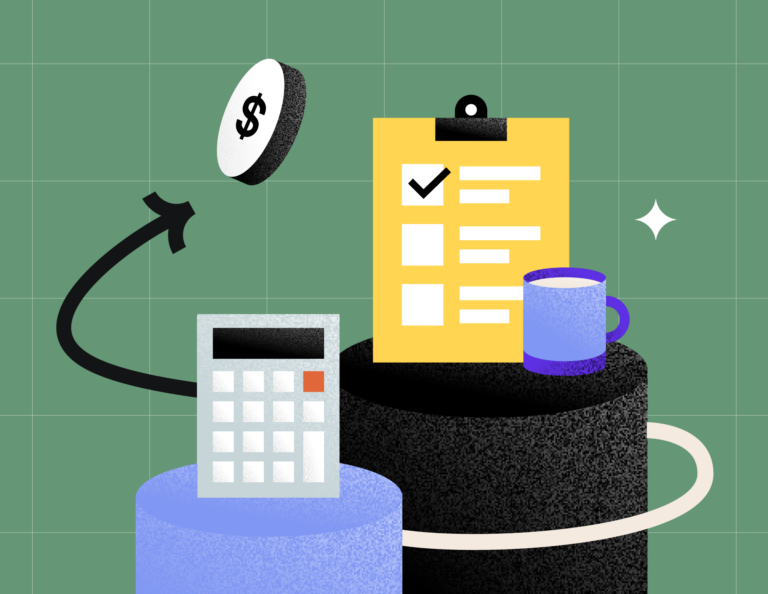A consulting retainer fosters long-term, collaborative client relationships, produces recurring revenue streams, and positions the professional services provider as a strategic partner. By following the best practices listed below, you can leverage a retainer to demonstrate your value beyond individual projects.

Shifting from a per-project consulting fee to a consultant retainer model can transform your business and enable strategic scaling. This approach frees you from the constant pursuit of new clients. Instead, you can cultivate relationships with a select group of high-value clients who provide a steady stream of projects and revenue. These clients appreciate the ongoing access to your expertise and experience.
Successfully executing a retainer starts with understanding what a retainer is, who benefits from it, and the steps involved in a successful implementation.
Jump to:
- What Is a consulting retainer for professional services firms?
- Why a consulting retainer strategy is a must-have for professional services consultants
- What are the benefits of a retainer for professional services providers?
- What are the benefits of a retainer for a client?
- What types of professional services providers use a retainer-based approach?
- How does a retainer fee differ from a consulting fee?
- What terms are included in a consulting retainer agreement?
- What are the consequences of not having a consulting retainer agreement in place?
- How do professional services firms determine the appropriate retainer fee?
- Example: How a digital marketing professional services firm might calculate retainer fees for a sports shoe company
- Best practices for professional services firms when negotiating retainer fees with clients
- Best practices for professional services firms when implementing a retainer-based model
- How a retainer-based approach can help professional services firms build long-term client relationships
- How a retainer-based approach can help consulting firms differentiate themselves from competitors
- Path to scaling and growing revenue streams

Use ready-made attorney-review contract templates on HoneyBook.

What is a consulting retainer for professional services firms?
A consulting services retainer is an agreement between a client and a consulting firm where the client pays a fee upfront to secure the consultant’s services for a specific period. This fee ensures that the consultant is available to provide their expertise and advice whenever the client needs it during that period.
There are two main types:
- Hourly retainer: The client pays for a set number of hours of the consultant’s time each month.
- Pay-for-access retainer: The client pays for ongoing access to the consultant’s knowledge. They can call on the consultant whenever they need help, regardless of how much time it takes.
Why a consulting retainer strategy is a must-have for professional services consultants
Retainer strategies are a popular business approach for professional service providers, like consultants, marketers, and IT specialists. These strategies establish long-term client relationships through recurring, prepaid agreements. Retainer agreements clearly define the general scope of work and timelines, ensuring both parties have clear expectations. Importantly, while retainer strategies foster long-term commitment, the model also allows flexibility to adapt services to the client’s evolving needs and priorities without renegotiating the entire contract.
What are the benefits of a retainer for professional services providers?
- Predictable revenue and improved forecasting: Retainers provide a steady income stream, facilitating better cash flow and informed financial planning, which allows for strategic planning of operations, marketing, and business development.
- Stronger and more collaborative client relationships: Retainer agreements foster consistent client engagement, facilitating a deeper understanding of the client, and laying the groundwork for successful collaboration.
- Reduced administrative burden: With a set fee and scope, retainers minimize the time spent on tasks like billing and contract negotiation, allowing more time to be spent on building the business.
- Efficient resource management: With predictable workloads from retainer agreements, firms can manage their resources more effectively, ensuring they have the right staff available at the right times.
- Better planning and forecasting: Steady work from retainers allows firms to plan their operations, marketing, and business development efforts more strategically, improving overall business performance.
- Quality control: Ongoing engagement through retainers helps firms develop a deeper understanding of their clients’ needs, enabling them to provide more tailored, impactful, and higher-quality solutions.
- Efficient time management: Knowing the scope of work covered by the retainer allows the service provider to schedule tasks and allocate resources more effectively, leading to improved project delivery and client satisfaction.
- Competitive advantage: Retainers enable professional services firms to position themselves as long-term strategic partners rather than just one-off service providers, enhancing their value proposition.
What are the benefits of a retainer for a client?
- Guaranteed access: Clients are assured access to the service provider’s expertise as needed, without renegotiating terms for each new project.
- Consistency and reliability: By fostering consistency and knowledge sharing, the retainer model can lead to better outcomes for clients.
- Budgeting: Clients can better predict their consulting expenses and avoid unexpected costs, as the retainer fee is typically a fixed, recurring amount.
- Partnership approach: Retainer arrangements foster a deeper, more collaborative relationship between the consultant and the client.
- Strategic continuity: Retainer engagements allow consultants to focus on long-term strategic goals rather than short-term project deliverables.
- Proactive strategy: Consultants can take a proactive approach to advising, helping clients anticipate and prepare for future challenges rather than just reacting to immediate issues.
- Tailored services: Consultants can offer more customized and flexible services under a retainer, adapting to the evolving needs of the client over time.
What types of professional services providers use a retainer-based approach?
Professional service firms across various industries use a retainer-based approach, including:
- Marketing, advertising, public relations and social media firms
- Design and creative firms
- Legal firms
- Management or business consulting firms
- IT services
- Financial advisory and accounting firms
- Human resources and recruitment firms
- Architectural and engineering firms
- Healthcare, medical billing, and medical consulting firms
How does a retainer fee differ from a consulting fee?
In the professional services industry, a retainer fee and a consulting fee represent two distinct compensation and client-service arrangements.
With a retainer fee, the client pays the service provider a predetermined amount upfront to secure ongoing services for a specified period. In a consulting fee arrangement, the client pays the professional services provider for specific advisory services or projects. Consulting fees are typically based on the amount of work performed or time spent.
What you need to know about retainer fees
- A retainer often signifies a continuous relationship between the client and the service provider, ensuring the provider’s availability for future work.
- A retainer fee ensures the client priority access and is typically paid in advance, either as a fixed monthly amount or a one-time payment covering a longer period.
- Depending on the agreement, the scope of the retainer fee can be broad or specific and can include a variety of services.
What you need to know about consulting fees
- Consulting fees are typically based on specific projects or tasks and calculated based on actual time and resources spent per project.
- Consulting engagements usually have a clearly defined scope, deliverables, and timelines agreed upon in advance.
- Clients seek consultants for their specialized knowledge to address particular challenges, opportunities, or projects.
What to consider when deciding to bill by retainer or consulting fee
What is the client’s commitment?
- Retainer: Continuous, long-term, strategic focus.
- Consulting: Discrete, short-term, or project-specific.
What financial commitment makes sense?
- Retainer: Fixed, regular payments.
- Consulting: Variable, based on work completed.
What level of service is required?
- Retainer: Prioritized, with the professional often on-call for the client.
- Consulting: Limited to the agreed project or timeframe.
What terms are included in a consulting retainer agreement?
A consulting retainer agreement typically includes the following terms to clearly define the relationship between the service provider and the client:
- Scope of services: Detailed description of the services to be provided under the retainer.
- Retainer fee: The amount to be paid, how it will be billed (e.g., monthly, quarterly), and any upfront payments required.
- Payment terms: When and how payments are to be made, including due dates and accepted payment methods.
- Duration of agreement: The length of time the retainer agreement will be in effect, and any provisions for renewal or termination.
- Availability and response time: Expectations regarding the availability of the service provider and response times for addressing client requests or issues.
- Usage limits: Any limits on the amount of work or number of hours included in the retainer fee, and terms for handling overages.
- Termination clause: Conditions under which either party can terminate the agreement, including required notice periods and any associated penalties or refunds.
- Confidentiality: Provisions to protect sensitive information exchanged between the client and the service provider.
- Intellectual property rights: Clarification of who owns the intellectual property created during the course of the retainer.
- Liability and indemnification: Terms outlining the extent of the service provider’s liability and any indemnification obligations of the client.
- Performance metrics and reporting: Criteria for measuring the service provider’s performance and any reporting requirements to keep the client informed of progress.
- Dispute resolution: Methods for resolving any disputes that arise, such as arbitration or mediation, and the applicable jurisdiction.
- Client responsibilities: Client obligations to facilitate the service provider’s work, such as providing necessary information and access to resources.
- Force majeure: Provisions for handling situations where performance is affected by events beyond the control of either party (e.g., natural disasters, pandemics).
- Amendments: Process for making changes to the agreement, typically requiring written consent from both parties.
What are the consequences of not having a consulting retainer agreement in place?
Both the professional services provider and the client face the following potential risks by not deploying a consulting retainer agreement.
- Without a written agreement, there may be ambiguity or misunderstandings about the scope of services, deliverables, timelines, and responsibilities of each party. This can lead to disputes, missed expectations, and potential legal issues.
- Lacking a clear agreement may lead to disagreements about the fees, payment schedules, and billing arrangements, resulting in payment disputes, delayed payments, or non-payment issues.
- Without a confidentiality clause, there may be no legal protection for sensitive client information or data shared during the engagement, exposing both parties to potential data breaches or misuse of confidential information.
- If intellectual property rights are not clearly defined, there may be conflicts over ownership and usage rights of any work products or deliverables created during the engagement.
- Without clear termination clauses, there may be uncertainties about the conditions and procedures for ending the engagement, notice periods, and potential penalties.
- In the event of disagreements or conflicts, the absence of a dispute resolution clause can make it challenging to resolve issues through mediation, arbitration, or legal means.
- Operating without a formal agreement can expose both parties to potential legal risks, liabilities, and costly lawsuits due to the lack of clear terms and conditions.
- Disputes or misunderstandings arising from the lack of a retainer agreement can harm the professional reputation and credibility of the service provider or agency.
How do professional services firms determine the appropriate retainer fee?
Professional services firms determine the appropriate retainer fee by considering several key factors. These typically include an analysis of the firm’s costs, the scope of work, the client’s needs, industry standards, and the value provided to the client. By considering these factors, professional services firms can set a retainer fee that is fair, competitive, and reflective of the value delivered to the client, while also ensuring the firm’s profitability and sustainability.
Example: How a digital marketing professional services firm might calculate retainer fees for a sports shoe company
Step 1: Define the scope of deliverables
The firm and the sports shoe company agree on the following services to be provided on a monthly basis:
- Social media management (daily posts, engagement, and analytics)
- Content creation (blog posts, newsletters, and promotional materials)
- Search engine optimization (SEO) and search engine marketing (SEM)
- Monthly performance reports and strategy meetings
Step 2: Estimate the time needed
The firm estimates the total number of hours required per month for each service:
- Social media management: 40 hours
- Content creation: 30 hours
- SEO and SEM: 20 hours
- Monthly reports and meetings: 10 hours
- Total estimated hours: 100 hours
Step 3: Determine the hourly rate
The firm sets its hourly rate based on market rates, expertise, and overhead costs. For this example, the hourly rate is $150.
Step 4: Calculate the base retainer fee
The base retainer fee is calculated by multiplying the total estimated hours (100) by the hourly rate ($150) = $15,000
Step 5: Add a safety net
To cover any unexpected costs or additional time, the firm adds a 10% buffer: $1,500
Step 6: Final retainer fee calculation
The final retainer fee is the sum of the base retainer fee and the safety net: $15,000 + $1,500 = $16,500
Step 7: Draft the retainer agreement
The firm drafts a retainer agreement that includes:
- Basic details: Names, addresses, and contact information of both parties
- Scope: Detailed description of the services to be provided
- Duration: Monthly retainer with an initial term of six months
- Payment terms: Monthly payments due at the beginning of each month
- Retainer fee amount: $16,500 per month
- Rights and obligations: Expectations and responsibilities of both parties
- Other clauses: Dispute resolution, termination, and other necessary legal clauses
Step 8: Set Up Payment Collection
The firm sends the contract and sets up automatic monthly payments.
By following these steps, the digital marketing professional services firm ensures that the retainer fee is calculated transparently and aligns with the value provided to the sports shoe company. This approach helps in maintaining a steady cash flow and fosters a long-term relationship with the client.
HoneyBook’s all-in-one clientflow platform enables business owners to manage their business in one place, including invoicing and billing. HoneyBook makes it easy to develop online contracts from legally vetted templates. Using a template is an easy way to get started with your contract. Templates give you the foundation for the contract and include all the essentials of a good contract. You can amend and append the template to suit your purposes.
Whichever way you write your agreement, seek legal counsel to ensure your terms and conditions are legally compliant in your state and that the agreement or contract offers the level of protection you need.
Best practices for professional services firms when negotiating retainer fees with clients
The aim of good negotiations should be a happy client who is more likely to extend the retainer and become a long-term client. So how do services providers achieve this goal? It starts with building trust. Trust is established through the following 5 overarching actions:
- Being transparent about your pricing structure and the factors influencing the retainer fee.
- Fostering a collaborative negotiation process.
- Communicating clearly throughout the negotiation, which includes actively listening to client concerns and addressing them openly.
- Emphasizing your value proposition, which includes your experience, expertise, and the benefits of having dedicated and readily available support.
- Working toward a win-win outcome where both parties feel the retainer agreement is fair and beneficial.
The following 12 steps help the services provider create a thoughtful, thorough, and equitable presentation that benefits both parties:
- Conduct a thorough initial consultation to understand the client’s needs, goals, and the specific services they require. Here’s where you clearly define the scope of work, deliverables, time and resources, and any exclusions.
- Prepare a detailed proposal outlining the services to be provided, the expected outcomes, and the value these services will bring to the client.
- Consider presenting tiered retainer structures with varying service levels and pricing to cater to different client budgets and needs.
- Calculate the cost of providing the services, including labor, overhead, and any additional expenses to ensure that the retainer fee covers all costs and provides a reasonable profit margin.
- Focus on performance and results. In communicating with your client, emphasize how the services and support you render will benefit the client in achieving their business goals. Provide case studies or references from other clients who have benefited from similar retainer arrangements.
- Firms may reference industry standards or benchmarks for retainer fees in their specific field or service area to support their proposed fee structure.
- Define the payment schedule (e.g., monthly, quarterly) and the preferred payment method. Include any terms for handling late payments or adjustments.
- Establish performance metrics to measure the success of the services provided. This proves value and justifies the retainer fee.
- Set expectations for how and when progress reports will be delivered and regular reviews with the client.
- Allow for flexibility. Changes in client’s needs or changing market conditions might require adjustments to the scope of work within the retainer — including how additional work or reduced services will be handled.
- Draft a formal contract that includes all agreed-upon terms, conditions, and fee structures. Have the contract reviewed by legal professionals to ensure compliance. HoneyBook offers attorney-vetted contract templates.
- Establish an onboarding process to foster a successful partnership. This includes implementing discovery meetings and setting up channels to facilitate quick and easy communications.
Best practices for professional services firms when implementing a retainer-based model
Professional services firms can fully leverage the benefits of a retainer-based approach by following these four tips:
Manage your resources wisely: Practice capacity planning when allocating resources to handle the workload from retainer clients. Staff should be well-trained and understand the specific needs of these clients.
Onboard the client: Educate clients on how the retainer works, what to expect, and how to get the most value from the agreement. Most importantly, manage expectations by clearly communicating the limits of the retainer.
Leverage technology to automate and streamline service delivery and back-office operations: This includes using project management and time-tracking tools to monitor retainer work and ensure efficient service delivery. Implement automated billing systems to streamline payments and reduce administrative, labor-intensive work.
HoneyBook’s all-in-one, end-to-end clientflow management platform empowers independent business owners to manage and scale their businesses in one place. It seamlessly combines booking, invoicing, and billing with other essential features like lead capture, project management, and client communication, minimizing the need for additional software solutions.
Establish a planned and proactive communications approach: Schedule regular meetings with clients to discuss progress, address concerns, and ensure the work aligns with their goals. As the work progresses, proactively identify new needs and suggest solutions within the retainer’s scope.
In addition, regularly conduct client satisfaction surveys to gauge the effectiveness of your retainer program and identify areas for improvement.
How a retainer-based approach can help professional services firms build long-term client relationships
Retainer agreements inherently foster regular communication between the professional services provider and the client. This ongoing interaction strengthens the relationship by fostering a deeper understanding of the client’s business, challenges, competitors, and industry trends.
Furthermore, retainer agreements support long-term client relationships by:
- Enabling the services firm to contribute to the development and execution of long-term strategies, demonstrating their value beyond individual projects.
- Offering a broader range of services tailored to the client’s overall needs, not just single projects.
- Providing the flexibility to adapt services as the client’s needs evolve.
How a retainer-based approach can help consulting firms differentiate themselves from competitors
Professional services providers can leverage the benefits of a retainer model to stand out from its competitors by:
- Highlighting in its marketing materials the benefits of retainer-based partnerships, focusing on how it fosters deeper collaboration, delivers higher value, and ensures consistent support.
- Demonstrating the tangible results achieved for clients through a long-term partnership through case studies and testimonials.
- Offering tiered retainer packages catering to different client needs and budgets.
- Providing specialized services conducive to long-term consulting efforts.
Path to scaling and growing revenue streams
Long-term, ongoing client relationships; predictable revenue; and clearly defined projects and timelines are among the many reasons why consulting retainers are popular with professional services providers. Firms that adopt a retainer model gain a competitive advantage by positioning themselves as long-term strategic partners. Continuous collaboration with clients allows them to deliver more tailored and impactful solutions while maintaining consistent standards, ultimately leading to higher-quality outcomes.
The multifaceted nature of today’s business environment, driven by complexity, interconnectedness, and rapid change, necessitates longer-range thinking, deeper insights, and diverse skills – all hallmarks of a successful consulting-retainer model.




